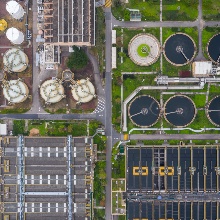The Department of Multiscale Environmental Process Engineering (MUVT) focuses on researching scientific methods, developing technical processes, and implementing them into real-world contexts. With our technical solutions and concepts, we contribute to the protection of our environment while simultaneously promoting the sustainable development of our modern society. Throughout the technology development process, we cover all scales of technical evolution: from laboratory experiments to pilot scales and up to large-scale engineering. For the practical application of our innovative technical approaches, we develop concepts and strategies, some of which we test in real-world laboratories. In doing so, we support, for example, the responsible decision-makers from politics and society when it comes to the concrete implementation of innovative and risk-associated projects. Our research and development efforts benefit from the multidisciplinary orientation of the ISWA institute. Scientists, engineers, and technicians work hand in hand.
Projects
Adaptation of Rainwater Management to Extreme Events (AMAREX) Addressed SDGs: 9, 11, 13
In AMAREX, possibilities for adapting rainwater management to increasing extreme stresses from heavy rainfall and drought are being developed as a key contribution to climate change adaptation. Additionally, the disturbed urban water balance is reviewed as a central evaluation indicator for water extremes. Through rainwater utilization, local infiltration, and evaporation, particularly high and rapid rainwater discharges are aimed to be reduced or avoided. Positive effects of RWB (Rainwater Balance) include improved groundwater regeneration and the reduction of heat stress through evaporative cooling.
Biowaste to Products (BW2Pro) Addressed SDGs: 9, 11, 12, 13
The Biowaste to Products (BW2Pro) project makes a positive contribution to climate neutrality by introducing bio-residues as a valuable raw material for the highest possible quality material use. An existing bio-residue utilization plant is to be expanded into a decentralized biorefinery with the capability to extract secondary raw materials and final products. Through the biorefinery, four high-quality secondary raw materials (fibers, cellulases, polyhydroxyalkanoates, and biogas) and two finished products (biodegradable plant pots and fertilizer) are to be produced. https://www.biooekonomie-bw.de/fachbeitrag/aktuell/biowaste-products-bioraffinerie-verwandelt-bioabfall-neue-produkte
Rural Urban Nutrient Partnership (RUN) Addressed SDGs: 9, 11, 12, 13
Within RUN, practical technologies are developed that are tested for ecological, economic, and societal sustainability to process bio-residues and parts of wastewater from settlements and transform them into safe design fertilizers, recycled plastic films, or biochar for agriculture. The interplay between sustainable agricultural production and the future-oriented consumption behavior of urban residents is being researched.


